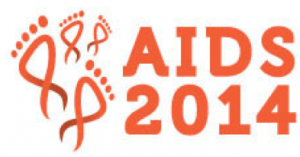No difference in overall anaemia rate with reduced dose AZT
1 August 2014. Related: Conference reports, Treatment strategies, Treatment access, World AIDS 20 Melbourne 2014.
 Polly Clayden, HIV i-Base
Polly Clayden, HIV i-Base
A study looking at reduced dose AZT showed no difference in overall rate of anaemia but demonstrated improved safety and similar efficacy compared to standard dose. These findings were presented as a late breaker poster at AIDS 2014. [1]
If tenofovir remains the preferred NRTI for first-line treatment, as recommended in the 2013 World Health Organisation (WHO) guidelines, people switching to second-line are likely to receive AZT.
According to previous global market forecasts, cost savings from a daily dose reduction of AZT from 600 mg to 400 mg would be US $89 to 60 per patient per year, saving US $282 to 351 million on antiretrovirals over three years. [2]
The MiniZID study – conducted by Matieu Rougemont and colleagues from the National Social Insurance Hospital, Yaounde, Cameroon, University of Geneva, Switzerland and University of Liverpool, UK – compared reduced dose (400 mg) of AZT with standard dose (600 mg) in treatment naïve adults. Because reducing the dose might decrease side effects of AZT, the primary outcome of the study was the difference in the proportion of participants with a new grade 1 to 4 anaemia or increased anaemia grade at 24 weeks.
The study was a prospective, randomised, controlled trial conducted at one HIV clinic in Yaoundé, between August 2011 and December 2013. Eligible adults (<350 CD4 cells/mm3) received 3TC plus nevirapine with either 600 mg or 400 mg of AZT.
Participants included in the intention-to-treat (ITT) analysis (n=142) were 59% women and a median of 35 years of age. At baseline, participants were a median: BMI 23.2 kg/m2 (IQR 21-26), hemoglobin 11.6 g/dL (IQR 10.8-12.8), CD4 count 163 cells/mm3 (IQR 99-219) and viral load 5.4 log10 copies/mL (IQR 4.9-5.9).
After 24 weeks of follow up, 50 participants (35%) had a new or worsening anaemia grade overall. The investigators reported no statistically significant difference between the 400 mg and 600 mg AZT arms: 38% vs 33%, p=0.56.
Significantly fewer participants in the 400 mg AZT arm needed to switch to tenofovir because of AZT-related anaemia: 1.4% vs 11.4%, p=0.017. Fewer participants in the lower dose arm required a blood transfusion, but the difference was not statistically significant: 2.8% vs 5.7%, p=0.44.
Of the 50 participants with anaemia, significantly fewer in the 400 mg AZT arm experienced severe anaemia (< 8 g/dL): 11/1% vs 34.8%, p=0.03.
The investigators noted that, participants in the two treatment groups had similar virological response at 24 weeks – although the sample size was not powered to demonstrate non-inferiority. CD4 cell count increase was also similar across the two arms. They recommend a larger phase 3 non-inferiority trial using AZT-based ART second-line in low-income settings.
Comment
Although this work seemed a good idea at the time, retrofitting old drugs for low-income countries might not be the best use of resources. We have made the same comment several times about low dose d4T.
The important work at the moment is optimising the dose of darunavir/ritonavir and making sure that there are research programmes to generate data on newly approved and pipeline antiretrovirals – dolutegravir and tenofovir alafenamide (TAF) – to inform the best and simplest future options for low-income countries.
References:
- Rougemont M et al. The MiniZID study: a randomized controlled trial on safety of reduced dose (400 mg) of zidovudine compared with standard dose (600 mg) in HIV-infected patients starting antiretroviral therapy. 20th International AIDS Conference. Melbourne. 20-25 July 2014. Poster abstract LBPE16.
http://pag.aids2014.org/abstracts.aspx?aid=11206 - Crawford KW et al. Optimising the manufacture, formulation, and dose of antiretroviral drugs for more cost-efficient delivery in resource-limited settings: a consensus statement. Lancet Infect Dis 2012 Jul;12(7):550-60.
http://www.thelancet.com/journals/laninf/article/PIIS1473-3099(12)70134-2/abstract

